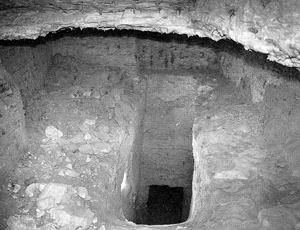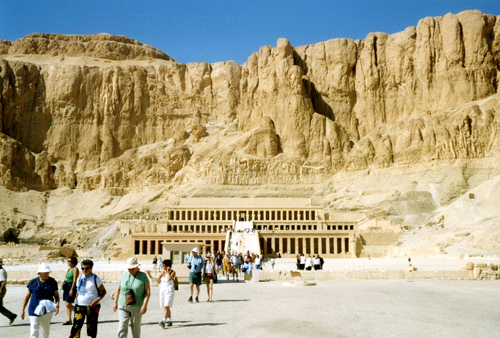The temple of Karnak was known in ancient times as Ipet Issut - The Most Perfect of Places. It is an enormous complex of pylons (huge gateways), columns, courts, obelisks and chapels, built in stages by pharaohs from the Middle Kingdom through to the Ptolemaic period, but mainly by New Kingdom pharaohs. There are parts built by Ramses II, Seti I, Amenhotep III, Thutmose I and III, Hatshepsut, and others.
Karnak was a temple dedicated mainly to Amun,
the king of the gods and the god of Thebes. There are also temples or
chapels to Amun's wife Mut, their son Montu, and to Osiris, Khons, and Ptah.
It's a truly amazing place you can get lost in, exploring the wonderful
hieroglyphs and images all over the walls and columns. My favourite part of
it is the hall of columns built by Ramses II and his father Seti I. These
columns are enormous - 50 people could stand on top of each one. And there
are over a hundred of them crowded together, creating a feeling of a dark
forest of giant redwoods.
There's also a sacred pool where the priests would wash before religious ceremonies to purify themselves. This was built by Thutmose II so was not around at the time of my story. In fact Karnak was far smaller in the time of Hatshepsut than it is now.
Click here to learn more: http://www.touregypt.net/karnak.htm
And here: http://en.wikipedia.org/wiki/Karnak
Hatshepsut had two pairs of obelisks made for Karnak Temple. The first were positioned at the far side from the entrance and supposedly were completely covered in electrum (a naturally occurring mix of silver and gold). The second pair were commissioned in year 15 of her rule and were completed about a year later. The construction and the transporting of the second pair stone was commemorated on the wall of the lower portico of Hatshepsut's temple, Djeser Djeseru. This would have been an incredible task. The obelisks were 29 metres long and weighed about 450 tons. They were a single block, so they would have been immensely difficult to move from the quarry in Aswan, onto their enormous barges, then off the barges in Thebes and in place at the temple. There are various theories as to how they were raised, such as by using levers - or try this insane idea that the Egyptians used kites.
The top of one of the destroyed obelisks,
showing Amun and Hatshepsut.
The Inscription on the obelisk which still stands, and which features in the story, is all about Hatshepsut, her father Thutmose I, and her other father Amun, to whom the obelisks were dedicated. Read the whole inscription here.
Hatshepsut's tomb is referred to as KV20 (King's Valley tomb number 20). It is in the Valley of the Kings on the west side of the river at Luxor, and was the first tomb to be built there. There are at least 63 tombs now in the Valley - a new one was discovered last year.
KV20 was originally built for Hatshepsut's father, Thutmose I. It is a very long tunnel, roughly dug out, descending into the rock for some 200 metres. The bottom is 100 metres below the surface. When Hatshepsut became king she decided she wanted to be buried with her father and had an extra chamber cut via Thutmose's burial chamber. This new chamber was much neater and had three
pillars in the middle along with three small storage rooms. Above: the first chamber of KV20
Entrance to KV20
In 1903 Howard Carter cleared out KV20, which
was a difficult and unpleasant task as it was filled with rubble. At last
Carter reached the burial chamber which had a collapsed ceiling. Here the
work was worst of all. Here's a quote from Carter: '...the air had become so
bad, and the heat so great, that the candles carried by
the workmen melted, and would not give enough light to enable them to
continue their work.' Also, dried bat poo from centuries was everywhere and
created suffocating clouds wherever the men worked. Nasty.
In the burial chamber Carter found two stone sarcophagi, one for Thutmose I and one for Hatshepsut, plus Hatshepsut's Canopic chest. However neither of the mummies were there, nor any treasure - just some fragments of wood, pottery, and stone vessels. There were also 15 polished limestone slabs inscribed in red and black ink with chapters from the Amduat, a book about the afterlife. These were intended to line the walls, but were lying around, abandoned by the workers (see chapter 11).

Thutmose I, by the way, did not end up being buried here - Thutmose III had a new tomb built for him (KV38), perhaps because he didn't want his brilliant grandfather associated with his horrid stepmother. Eventually Thutmose I's mummy ended up in a cache (a hidden store) of lots of mummies, found near Hatshepsut's temple in the late 1800s. His body is now in the Cairo museum.
Left - Hatshepsut's sarcophagus, now in the Cairo Museum
Hatshepsut's temple in Deir el-Bahri was known as Djeser Djeseru in ancient times - the Holy of Holies. It's one of the most beautiful buildings in Egypt - indeed some say the world. The design is very unusual for ancient Egypt, with three terraces fronted by porticoes - rows of columns. It was clearly designed to suit its environment - the bay of cliffs which surround it like the shell of an oyster.
The temple contains various chapels, to gods such as Re, Anubis, Hathor, and most importantly Amun. The most sacred part of the temple was the inner sanctuary of Amun, cut into the rock at the back of the upper terrace. There were also chapels to Thutmose I and to Hatshepsut herself. And there are numerous beautifully carved and painted reliefs and statues, which tell us much about our great queen.
Click here for a map of the temple
The Frescoes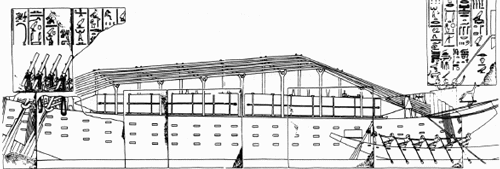
The walls at the back of the porticoes are painted with scenes relating to Hatshepsut's life.
Lower left Portico: the transport and erection of obelisks from Aswan to Karnak. An enormous barge was used to carry both obelisks - see the line drawing of the painting here.
Lower right portico: ritual hunting and fishing scenes

Middle terrace left portico: Hatshepsut's famous expedition to Punt. Punt is believed to be a region on the coast of Ethiopia or Somalia. In about year 8 of her reign Hatshepsut sent ships down the Red Sea on a trading trip to get myrrh incense, and 31 living myrrh trees (planted in the temple grounds), and other exotic goods like ivory, ebony (dark wood), leopard skins, baboons, monkeys, spices, and gold.

Carrying Myrrh trees
Below: the fat queen of Punt


Middle terrace right portico: Hatshepsut's divine birth. These scenes show Amun coming to Hatshepsut's mother and impregnating her with his breath. He then orders the god Khnum to make a body for her on his potter's wheel (see left), and her mother is shown pregnant.
Upper terrace: the walls around the
upper court were decorated with scenes showing the Beautiful Feast of the
Valley (see chapter 9). The Inner sanctuary of Amun had scenes showing the
royal family (Hatshepsut, Thutmose III, and princess Neferure) carrying out
religious rites. 
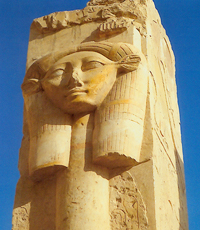
Statues of Hatshepsut as Osiris were found along the front of the columns on the upper terrace, and also inside the inner sanctuary and in niches in the upper court. There were also sphinxes of Hatshepsut lining the path across the middle terrace, and the road leading away from the temple. Most of the statues of Hatshepsut in the temple were destroyed by Thutmose III, however.
Chapel of Hathor: This was an important part of the temple. Hathor was the goddess of love, beauty, motherhood, and cemeteries. Deir el-Bahri as a whole was sacred to her, and Hatshepsut seems to identified with her. The chapel of Hathor to the left of the middle terrace is filled with beautiful statues and inscriptions.
I could say a lot more about Hatshepsut's temple - it is a treasure trove of Egyptian art, history and religion. To find out more, try these websites:
http://www.egyptsites.co.uk/upper/luxorwest/temples/hatshepsut.html Column with head of Hathor
http://www.bluffton.edu/~sullivanm/egypt/deirelbahri/deirelbahri.html (with cow's ears)
 Karnak
Karnak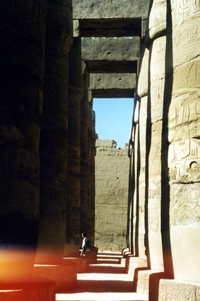
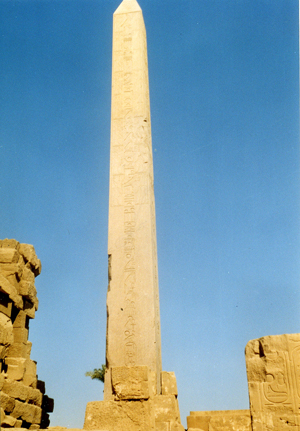 The
Obelisk
The
Obelisk
 KV20
KV20